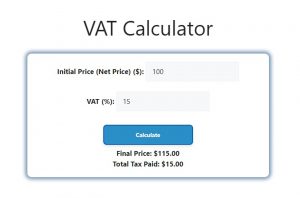About VAT Calculator (Formula)
A VAT Calculator helps businesses and consumers easily calculate the total cost of goods or services by factoring in the Value Added Tax (VAT). VAT is a consumption tax applied to products at every stage of production, and knowing how to calculate it is essential for pricing, purchasing, and bookkeeping.
Formula
The formula to calculate the final price (Gross Price) with VAT is as follows:
Final Price (Gross) = Net Price + (Net Price × VAT Rate)
Where:
- Final Price: The price after adding VAT.
- Net Price: The original price before tax.
- VAT Rate: The percentage of VAT applied.
How to Use
To use the VAT Calculator, follow these steps:
- Input the Net Price: Enter the price of the item or service before VAT is applied.
- Input the VAT Rate: Enter the VAT rate for your country or region.
- Calculate: The calculator will automatically calculate the final price, including VAT.
Example
If the net price of a product is $100, and the VAT rate is 15%, the calculation would be:
Final Price = $100 + ($100 × 0.15)
Final Price = $100 + $15 = $115
Thus, the gross price after adding VAT is $115.

FAQs
- What is VAT?
VAT (Value Added Tax) is a tax on the value added to goods and services at each stage of production or distribution. - How do I calculate VAT?
Multiply the net price by the VAT rate and add the result to the net price to get the gross price. - What is the VAT rate in most countries?
VAT rates vary by country, but they generally range between 5% and 25%. - Is VAT included in the final price of goods?
Yes, VAT is usually included in the final price, which means consumers pay the tax at the point of sale. - Can I subtract VAT from the final price to get the net price?
Yes, to get the net price from the final price, divide the final price by 1 plus the VAT rate (e.g., for 15% VAT, divide by 1.15). - Is VAT the same as sales tax?
No, VAT is applied at each stage of production, while sales tax is typically applied only at the point of sale. - Do all countries use VAT?
Many countries, especially in Europe, use VAT. However, some countries, like the United States, use sales tax instead. - What items are subject to VAT?
VAT applies to most goods and services, although some essential items may be exempt or taxed at a reduced rate. - Can businesses reclaim VAT?
Yes, in many cases, businesses can reclaim VAT paid on business-related purchases. - How often do VAT rates change?
VAT rates can change depending on government policies, so it’s important to stay updated on current rates. - What happens if I don’t charge VAT?
Businesses required to charge VAT must comply with tax regulations. Failing to charge VAT can lead to penalties. - Can I use this calculator for different countries?
Yes, as long as you know the VAT rate for the country, you can use the calculator to calculate VAT in any region. - Are there goods exempt from VAT?
Certain essential goods, such as basic food items and medical supplies, may be exempt from VAT in some countries. - What is the difference between gross and net prices?
The net price is the price before VAT, while the gross price includes VAT. - How do businesses calculate VAT for multiple products?
Businesses can apply the VAT rate to the total net price of all products to find the total VAT. - What does reverse charge mean in VAT?
Reverse charge means that the buyer, rather than the seller, is responsible for reporting VAT to tax authorities. - Do small businesses have to pay VAT?
VAT obligations vary by country, and small businesses may be exempt if their turnover is below a certain threshold. - How can I reduce the amount of VAT I pay?
Businesses can reduce VAT by claiming VAT refunds on business-related expenses, where applicable. - What documents do I need to track VAT?
Businesses should keep invoices, receipts, and VAT returns to accurately track VAT payments and claims. - How do I apply VAT if I offer discounts?
Apply the VAT rate to the discounted price rather than the original price to calculate the final amount with VAT.
Conclusion
A VAT Calculator simplifies the process of adding VAT to the net price, helping businesses and consumers stay on top of their finances. Whether you’re a business owner looking to set prices or a consumer calculating your expenses, this tool ensures accurate VAT calculations. Understanding how VAT works can help with budgeting and financial planning, so make sure to use this calculator to streamline your calculations.
